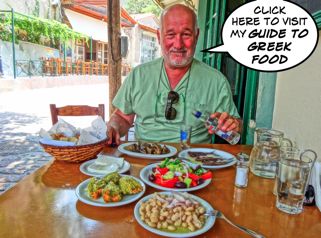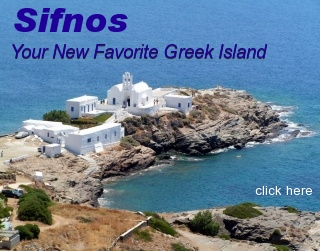Paradise Lost
|
|
Wow. I am really depressed. I am so depressed I want to share my depression. I want everyone who reads my site to feel as depressed as me, at least for just a little while. Then you can go back to being happy.
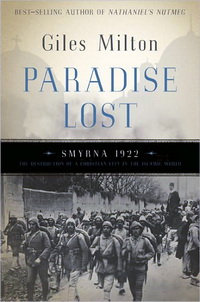 I just read Paradise Lost: Smyrna 1922-The Destruction of Islam's City of Tolerance by Giles Milton and though I have read several books and accounts on the Asia Minor Catastrophe as the Greeks call it or the Liberation of Turkey as the Turks call it, this book was the one that
really made
me question where we are going as human beings, based on what we have done in the not so distant past. I just read Paradise Lost: Smyrna 1922-The Destruction of Islam's City of Tolerance by Giles Milton and though I have read several books and accounts on the Asia Minor Catastrophe as the Greeks call it or the Liberation of Turkey as the Turks call it, this book was the one that
really made
me question where we are going as human beings, based on what we have done in the not so distant past.
For those of you who don't know the story I am going to give you the kindergarten version that would be taught in any school that was not trying to brainwash its students, meaning neither the Greek or the Turkish side.
At the end of the first World War, the Ottoman Empire, which had been allied with Germany so was on the losing side, was about to be carved up by the winners, Great Britian, France, Italy and the USA for the most part. Greece had entered the war very late and so was able to get in on the spoils and actually stood to gain much of the coast of Asia Minor which had a large Christian population, mostly Greeks who had pretty much always been there, even before the Turks
came from
the far east. The city of Smyrna was the last Christian city in Asia Minor, split between Greeks, Armenians, Jews and Turks, of which the Turks were the poorest, living in squalid conditions in their own quarter. The Greeks controlled much of the enterprise and there were also many western Europeans who had lived there for generations. It was a city of wide avenues, cafes, restaurants, theatre, galleries, colleges, department stores, foreign newspapers, music, and the most important cultural and commercial city
in the Middle East.
|
|
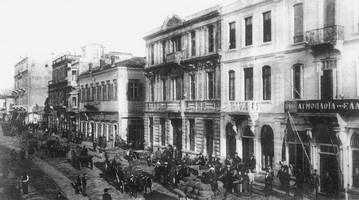 In 1919 the Great Powers, as they were called, decided to allow the Greek Army to occupy Smyrna to protect the Christians from the Turks, but really to protect their own claims from the Italians who were advancing up the southern coast. This played into Greek hands very well because ever since the fall of Constantinople they were waiting
for the day when they could reclaim the coast of Asia Minor. When the Greek army arrived in Smyrna they were met by thousands
of flag waving Smyrnion Greeks who were euphoric that the day of liberation had arrived. Prime Minister Eleftherios Venizelos had been the architect of the Megalo Idea, the 'Great Idea', which was the annexation of Smyrna and the whole coast including Constantinople which would have turned the Aegean into a Greek lake as it had been in ancient times. Right away though, the Greek soldiers created problems, abusing Turkish citizens and attacking a garrison of Turkish soldiers who really had no
orders to fight since at that point they did not even have a government. The Greek army then spread out to the countryside and burned Turkish villages and terrorized the Turkish population, probably not as policy, but thats what armies do sometimes when they are out of control and nobody stops them. This of course drove many Turks, who had been dispirited by the war and the collapse of their society, to join Kemal's Nationalist Army, which was based in Ankara. It had been a pretty ragtag group but the behavior
of the Greek Army gave it a cause, to rid Turkey of all Greeks and Christians and create an Islamic Turkey. Simply put, the Greek army inspired the Turks to band together with a passion they might not have had, if the Greeks had kept the peace instead of making Turkish civilians pay for 400 years of Ottoman occupation. In 1919 the Great Powers, as they were called, decided to allow the Greek Army to occupy Smyrna to protect the Christians from the Turks, but really to protect their own claims from the Italians who were advancing up the southern coast. This played into Greek hands very well because ever since the fall of Constantinople they were waiting
for the day when they could reclaim the coast of Asia Minor. When the Greek army arrived in Smyrna they were met by thousands
of flag waving Smyrnion Greeks who were euphoric that the day of liberation had arrived. Prime Minister Eleftherios Venizelos had been the architect of the Megalo Idea, the 'Great Idea', which was the annexation of Smyrna and the whole coast including Constantinople which would have turned the Aegean into a Greek lake as it had been in ancient times. Right away though, the Greek soldiers created problems, abusing Turkish citizens and attacking a garrison of Turkish soldiers who really had no
orders to fight since at that point they did not even have a government. The Greek army then spread out to the countryside and burned Turkish villages and terrorized the Turkish population, probably not as policy, but thats what armies do sometimes when they are out of control and nobody stops them. This of course drove many Turks, who had been dispirited by the war and the collapse of their society, to join Kemal's Nationalist Army, which was based in Ankara. It had been a pretty ragtag group but the behavior
of the Greek Army gave it a cause, to rid Turkey of all Greeks and Christians and create an Islamic Turkey. Simply put, the Greek army inspired the Turks to band together with a passion they might not have had, if the Greeks had kept the peace instead of making Turkish civilians pay for 400 years of Ottoman occupation.
|
|
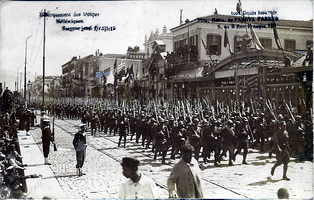 To make a long story short the Greek army decided to march inland and defeat Kemal once and for all. They had 200,000 men and people thought it would be easy. It wasn't. It was a disaster. The army was defeated to such an extent that they were no longer an army, just a large group of Greeks trying to get to the sea and
back to Athens, like Xenophon's men against the Persians two thousand years earlier. As they retreated they burned Turkish villages and as the Turks followed
them they burned Greek villages. Meanwhile in Smyrna, as soldiers and civilians began trickling, then pouring into the city, it became apparent that something terrible had happened. It was the last thing anyone expected, for the proud Greek army to be defeated, humiliated by Kemal's troops. Many of the Greek soldiers made it to ships and sailed back to Greece. Others were captured and sent on marches to the interior which meant they marched until they died or were shot. In the meantime Smyrna filled up with refugees
who were running from the Turks and several hundred thousand were gathered in the harbor. In the harbor also were the warships of every major power including the United States. To make a long story short the Greek army decided to march inland and defeat Kemal once and for all. They had 200,000 men and people thought it would be easy. It wasn't. It was a disaster. The army was defeated to such an extent that they were no longer an army, just a large group of Greeks trying to get to the sea and
back to Athens, like Xenophon's men against the Persians two thousand years earlier. As they retreated they burned Turkish villages and as the Turks followed
them they burned Greek villages. Meanwhile in Smyrna, as soldiers and civilians began trickling, then pouring into the city, it became apparent that something terrible had happened. It was the last thing anyone expected, for the proud Greek army to be defeated, humiliated by Kemal's troops. Many of the Greek soldiers made it to ships and sailed back to Greece. Others were captured and sent on marches to the interior which meant they marched until they died or were shot. In the meantime Smyrna filled up with refugees
who were running from the Turks and several hundred thousand were gathered in the harbor. In the harbor also were the warships of every major power including the United States.
|
|
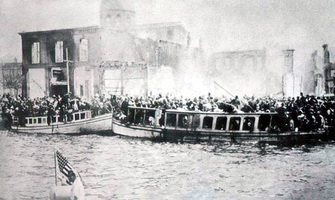 When the Turkish army arrived they told the people not to be afraid. But from the beginning there were isolated incidents of looting, rape and murder. On Wednesday Sept 13th fires broke out in the Armenian quarter of the city. Every eyewitness whether they are British, Italian, French, American, Greek or Armenian tells of Turkish soldiers
carrying drums of petrol and dousing buildings. The had waited til the wind was blowing away from the Turkish quarter and by the late afternoon
the fires had reached the harbor. By Thursday the city was a giant mass of flames, the largest fire in history, they say. The inhabitants of Smyrna had joined the refugees on the quay, held there by the flames on one side, the sea on the other and Turkish soldiers with machine guns on either end to stop people from escaping. The foreign warships were permitted to rescue only citizens from their own countries. It was obvious that a new Turkey was being reborn in the flames of Smyrna and they did not want
to risk any future business deals by aiding the enemy of their new friend. They watched as men, women and children burned, drowned or were killed by Turkish troops. When the Turkish army arrived they told the people not to be afraid. But from the beginning there were isolated incidents of looting, rape and murder. On Wednesday Sept 13th fires broke out in the Armenian quarter of the city. Every eyewitness whether they are British, Italian, French, American, Greek or Armenian tells of Turkish soldiers
carrying drums of petrol and dousing buildings. The had waited til the wind was blowing away from the Turkish quarter and by the late afternoon
the fires had reached the harbor. By Thursday the city was a giant mass of flames, the largest fire in history, they say. The inhabitants of Smyrna had joined the refugees on the quay, held there by the flames on one side, the sea on the other and Turkish soldiers with machine guns on either end to stop people from escaping. The foreign warships were permitted to rescue only citizens from their own countries. It was obvious that a new Turkey was being reborn in the flames of Smyrna and they did not want
to risk any future business deals by aiding the enemy of their new friend. They watched as men, women and children burned, drowned or were killed by Turkish troops.
When the fire was over there was nothing left of Smyrna except the Turkish Quarter and the Standard Oil Refinery! (Funny how that worked out)
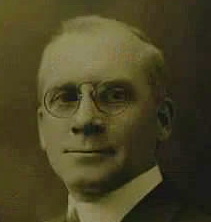 But there were still several hundred thousand burned and battered people on the docks. Kemal gave them 10 days to leave or they would be deported into the interior, which meant slavery and death. An American name Asa Jennings(photo) went to Mytilini and convinced the Greek government to let him take charge of some ships in the harbor that
had been used to evacuate the Greek army but had not returned for the civilians. Jennings successfully evacuated most of the survivors, though the
number of people unaccounted for is somewhere between a hundred and two hundred thousand people. But there were still several hundred thousand burned and battered people on the docks. Kemal gave them 10 days to leave or they would be deported into the interior, which meant slavery and death. An American name Asa Jennings(photo) went to Mytilini and convinced the Greek government to let him take charge of some ships in the harbor that
had been used to evacuate the Greek army but had not returned for the civilians. Jennings successfully evacuated most of the survivors, though the
number of people unaccounted for is somewhere between a hundred and two hundred thousand people.
In the next two years the remaining Christians in Asia Minor, over a million, were exchanged for the half a million Muslims who had been living in Greece, the largest example of ethnic cleansing in history. Most of them ended up in Athens, overwhelming the city and the country which was basically bankrupt because of the war. Turkey became a republic, and Kemal became Attaturk, the father of modern Turkey.
That's the outline.
The book is full of first hand narration and builds like the last voyage of the Titanic. You know what is going to happen, but the stories within the big story make you realize that this happened to real people. People who went through an unimaginable hell and lived to tell about it. There are villians and heroes but there are mostly victims. The new Turkey was baptised in the blood of innocent people including women and children. The United States, Great Britian
and all the
countries who stood by and did nothing were guilty of criminal negligence, at least. The Greek government as well. They were not willing to risk losing a ship to save their fellow Greeks. If it were not for the initiative of a private citizen, an American named Asa Jennings, the survivors would have been marched off into the desert to never be seen or heard from again. The story of Jennings, who knew nothing about sailing, but was made an admiral of the Greek navy and led a squadron of ships back and forth
in what had to be one of the largest rescue missions in history is what myths and movies are made out of.
There are some books of the disaster in Smyrna like Marjorie Houspain Dobkin's Smyrna 1922 or the account of George Horton, the American Consul of Smyrna's The Blight of Asia which are illuminating. But Milton's book puts it all together and tells us in an indisputable way that something really terrible happened in Smyrna, in September of 1922 and that those
who don't
know history, or deny it, are doomed to repeat it.
You can get it from Greece In Print. No matter what you believe or you think you know, you should read it.
I feel a little better now.
|
|

 I just read Paradise Lost: Smyrna 1922-The Destruction of Islam's City of Tolerance by Giles Milton and though I have read several books and accounts on the Asia Minor Catastrophe as the Greeks call it or the Liberation of Turkey as the Turks call it, this book was the one that
really made
me question where we are going as human beings, based on what we have done in the not so distant past.
I just read Paradise Lost: Smyrna 1922-The Destruction of Islam's City of Tolerance by Giles Milton and though I have read several books and accounts on the Asia Minor Catastrophe as the Greeks call it or the Liberation of Turkey as the Turks call it, this book was the one that
really made
me question where we are going as human beings, based on what we have done in the not so distant past. In 1919 the Great Powers, as they were called, decided to allow the Greek Army to occupy Smyrna to protect the Christians from the Turks, but really to protect their own claims from the Italians who were advancing up the southern coast. This played into Greek hands very well because ever since the fall of Constantinople they were waiting
for the day when they could reclaim the coast of Asia Minor. When the Greek army arrived in Smyrna they were met by thousands
of flag waving Smyrnion Greeks who were euphoric that the day of liberation had arrived. Prime Minister Eleftherios Venizelos had been the architect of the Megalo Idea, the 'Great Idea', which was the annexation of Smyrna and the whole coast including Constantinople which would have turned the Aegean into a Greek lake as it had been in ancient times. Right away though, the Greek soldiers created problems, abusing Turkish citizens and attacking a garrison of Turkish soldiers who really had no
orders to fight since at that point they did not even have a government. The Greek army then spread out to the countryside and burned Turkish villages and terrorized the Turkish population, probably not as policy, but thats what armies do sometimes when they are out of control and nobody stops them. This of course drove many Turks, who had been dispirited by the war and the collapse of their society, to join Kemal's Nationalist Army, which was based in Ankara. It had been a pretty ragtag group but the behavior
of the Greek Army gave it a cause, to rid Turkey of all Greeks and Christians and create an Islamic Turkey. Simply put, the Greek army inspired the Turks to band together with a passion they might not have had, if the Greeks had kept the peace instead of making Turkish civilians pay for 400 years of Ottoman occupation.
In 1919 the Great Powers, as they were called, decided to allow the Greek Army to occupy Smyrna to protect the Christians from the Turks, but really to protect their own claims from the Italians who were advancing up the southern coast. This played into Greek hands very well because ever since the fall of Constantinople they were waiting
for the day when they could reclaim the coast of Asia Minor. When the Greek army arrived in Smyrna they were met by thousands
of flag waving Smyrnion Greeks who were euphoric that the day of liberation had arrived. Prime Minister Eleftherios Venizelos had been the architect of the Megalo Idea, the 'Great Idea', which was the annexation of Smyrna and the whole coast including Constantinople which would have turned the Aegean into a Greek lake as it had been in ancient times. Right away though, the Greek soldiers created problems, abusing Turkish citizens and attacking a garrison of Turkish soldiers who really had no
orders to fight since at that point they did not even have a government. The Greek army then spread out to the countryside and burned Turkish villages and terrorized the Turkish population, probably not as policy, but thats what armies do sometimes when they are out of control and nobody stops them. This of course drove many Turks, who had been dispirited by the war and the collapse of their society, to join Kemal's Nationalist Army, which was based in Ankara. It had been a pretty ragtag group but the behavior
of the Greek Army gave it a cause, to rid Turkey of all Greeks and Christians and create an Islamic Turkey. Simply put, the Greek army inspired the Turks to band together with a passion they might not have had, if the Greeks had kept the peace instead of making Turkish civilians pay for 400 years of Ottoman occupation. To make a long story short the Greek army decided to march inland and defeat Kemal once and for all. They had 200,000 men and people thought it would be easy. It wasn't. It was a disaster. The army was defeated to such an extent that they were no longer an army, just a large group of Greeks trying to get to the sea and
back to Athens, like Xenophon's men against the Persians two thousand years earlier. As they retreated they burned Turkish villages and as the Turks followed
them they burned Greek villages. Meanwhile in Smyrna, as soldiers and civilians began trickling, then pouring into the city, it became apparent that something terrible had happened. It was the last thing anyone expected, for the proud Greek army to be defeated, humiliated by Kemal's troops. Many of the Greek soldiers made it to ships and sailed back to Greece. Others were captured and sent on marches to the interior which meant they marched until they died or were shot. In the meantime Smyrna filled up with refugees
who were running from the Turks and several hundred thousand were gathered in the harbor. In the harbor also were the warships of every major power including the United States.
To make a long story short the Greek army decided to march inland and defeat Kemal once and for all. They had 200,000 men and people thought it would be easy. It wasn't. It was a disaster. The army was defeated to such an extent that they were no longer an army, just a large group of Greeks trying to get to the sea and
back to Athens, like Xenophon's men against the Persians two thousand years earlier. As they retreated they burned Turkish villages and as the Turks followed
them they burned Greek villages. Meanwhile in Smyrna, as soldiers and civilians began trickling, then pouring into the city, it became apparent that something terrible had happened. It was the last thing anyone expected, for the proud Greek army to be defeated, humiliated by Kemal's troops. Many of the Greek soldiers made it to ships and sailed back to Greece. Others were captured and sent on marches to the interior which meant they marched until they died or were shot. In the meantime Smyrna filled up with refugees
who were running from the Turks and several hundred thousand were gathered in the harbor. In the harbor also were the warships of every major power including the United States.  When the Turkish army arrived they told the people not to be afraid. But from the beginning there were isolated incidents of looting, rape and murder. On Wednesday Sept 13th fires broke out in the Armenian quarter of the city. Every eyewitness whether they are British, Italian, French, American, Greek or Armenian tells of Turkish soldiers
carrying drums of petrol and dousing buildings. The had waited til the wind was blowing away from the Turkish quarter and by the late afternoon
the fires had reached the harbor. By Thursday the city was a giant mass of flames, the largest fire in history, they say. The inhabitants of Smyrna had joined the refugees on the quay, held there by the flames on one side, the sea on the other and Turkish soldiers with machine guns on either end to stop people from escaping. The foreign warships were permitted to rescue only citizens from their own countries. It was obvious that a new Turkey was being reborn in the flames of Smyrna and they did not want
to risk any future business deals by aiding the enemy of their new friend. They watched as men, women and children burned, drowned or were killed by Turkish troops.
When the Turkish army arrived they told the people not to be afraid. But from the beginning there were isolated incidents of looting, rape and murder. On Wednesday Sept 13th fires broke out in the Armenian quarter of the city. Every eyewitness whether they are British, Italian, French, American, Greek or Armenian tells of Turkish soldiers
carrying drums of petrol and dousing buildings. The had waited til the wind was blowing away from the Turkish quarter and by the late afternoon
the fires had reached the harbor. By Thursday the city was a giant mass of flames, the largest fire in history, they say. The inhabitants of Smyrna had joined the refugees on the quay, held there by the flames on one side, the sea on the other and Turkish soldiers with machine guns on either end to stop people from escaping. The foreign warships were permitted to rescue only citizens from their own countries. It was obvious that a new Turkey was being reborn in the flames of Smyrna and they did not want
to risk any future business deals by aiding the enemy of their new friend. They watched as men, women and children burned, drowned or were killed by Turkish troops.  But there were still several hundred thousand burned and battered people on the docks. Kemal gave them 10 days to leave or they would be deported into the interior, which meant slavery and death. An American name Asa Jennings(photo) went to Mytilini and convinced the Greek government to let him take charge of some ships in the harbor that
had been used to evacuate the Greek army but had not returned for the civilians. Jennings successfully evacuated most of the survivors, though the
number of people unaccounted for is somewhere between a hundred and two hundred thousand people.
But there were still several hundred thousand burned and battered people on the docks. Kemal gave them 10 days to leave or they would be deported into the interior, which meant slavery and death. An American name Asa Jennings(photo) went to Mytilini and convinced the Greek government to let him take charge of some ships in the harbor that
had been used to evacuate the Greek army but had not returned for the civilians. Jennings successfully evacuated most of the survivors, though the
number of people unaccounted for is somewhere between a hundred and two hundred thousand people.
